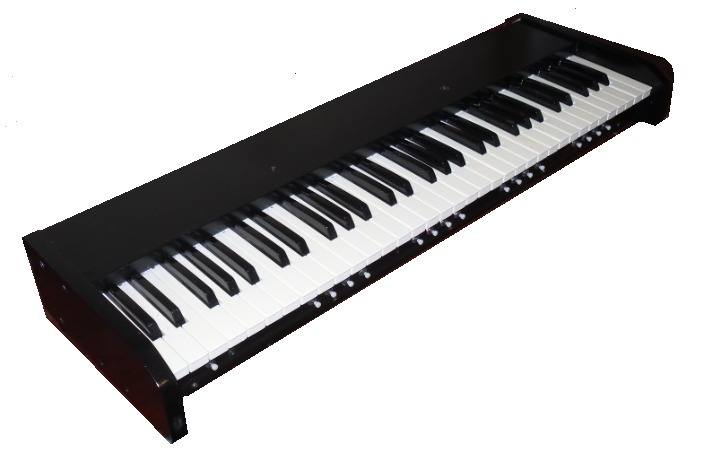John's Organ Works |
MS1 - One Keyboard MIDI stack

Although many organists will regard two keyboards as an absolute minimum, there are a few situations where this one-keyboard "stack" may prove useful, for example:
- where something very portable is needed
- for use as a "digital harmonium"
- to stand on top of an existing MIDI-capable instrument to provide an additional manual
The MS1 one-keyboard stack has 16 organ pistons (the same as the two-keyboard version) which can be used as combination pistons, couplers, or other organ controls. They can even carry out Hauptwerk menu commands.
The stack plugs directly into the USB ports of your computer. It incorporates reliable, well-proven M-Audio MIDI keyboard technology, but re-packaged in a much more organist-friendly format. Use the stack on its own, or combined with a MIDI pedalboard. Can be placed on a table, desk or other convenient surface, or built into an existing console.
The stack is guaranteed for one year. See Our Selling Policy for the terms of our guarantee.
Features at a glance
* one full-size 61 note keyboard
* 16 pistons arranged in four groups of four
* semi-weighted touch
* substantial bolted MDF chassis - no wobble!
* requires no external power supply and no batteries (draws power from USB connections)
* requires no MIDI-to-USB converter
* non-scratch feet (which may be removed if stack is to be bolted down)
* option to connect one or two swell pedals
* option to attach additional pistons
* option to add music stand
* finished in black (goes with anything!) Other colours are available
* can be transported in boot or back seat of most cars
* fully compatible with Hauptwerk
* a generic pdf User Guide is available from our Downloads page
* needs 2 available USB ports
Computer requirements
The MS1 should work with any reasonably up-to-date computer whether PC or Mac.
The stack is not in itself a musical instrument. It only works in conjunction with suitable software (eg Hauptwerk or Miditzer). Obviously, your computer must also meet the requirements for your chosen software.
Note: You will need 2 free USB ports to connect the stack (and you may need a further 2 for the Hauptwerk dongle and a MIDI pedalboard.) If your computer does not have sufficient ports, you can use a powered USB hub to expand it.
Physical dimensions
Overall width (side to side) 890 mm
Overall depth (front to back) 280 mm (approx)
Height with feet 110 mm (approx)
Height without feet 100 mm (approx)
Length of keys 137 mm
Bolt down sockets (with feet removed) 4 X M4
Keyboard touch
The keys are taken from an M-Audio Keystation 61 Mk3 MIDI controller keyboard, and have a touch which the manufacturer describes as “semi-weighted". This keyboard will give an enjoyable playing experience, and has an improved touch relative to the Mk2 Keystation keys used previously in the K-series stacks. However, please be aware that it does NOT simulate the touch of a tracker action instrument.
Pistons
The 16 pistons can be configured to do almost anything in Hauptwerk. Most obviously they can be used as combination pistons, but they can also carry out menu commands. Particularly useful ones are to advance the registration sequencer, or to start and stop the built-in recording. The pistons are not numbered, but they are grouped into fours for ease of identification.
Swell pedal connection
The rear panel of the MS1 includes two stereo jack sockets to which standard keyboard expression pedals can be attached. Useful if your pedalboard has no swell pedals (or not enough). Simply bolt additional expression pedal(s) to your pedalboard and pass the lead(s) up to the back of the stack.
Auxiliary piston ports
The rear panel of the MS1 provides two 9-way D sockets to which up to sixteen additional pistons (or other switch-type inputs) can be attached. One use for this feature is to add toe pistons to a pedalboard which doesn't have any (or not enough).
MIDI output channel
Keyboard MIDI output is on channel 1. For a small additional cost an extra piston can be fitted which allows selection of channel (1-16). This is not required for Hauptwerk use. Pistons always output on channel 1.
£433
Return to MIDI keyboard stack page